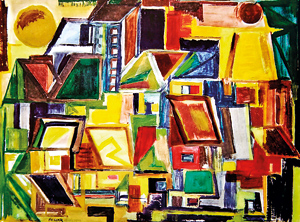Everything inspires him
Raja Segar would walk to school every day a fish bun in his hand, revelling at its triangular goodness, his eyes drawn to the unadorned beauty of the simple shape. Segar would happily chomp it down once the admiration wore off, but little did he know that simple geometric shapes would one day define him as an artist.

“That was my first love with geometric shapes,” says Segar. Today, the streaks of white on his beard tell of a man who has been in the profession for a long time and whose art has matured like fine wine. Geometric cubism is his forte. He has just launched his self-titled autobiography and with an exhibition opening today is ready for a fresh public appraisal of his work.
“This book has been in the pipeline for the past ten years,” says Segar, adding that he was sent from pillar to post in pursuit of a printer. “I had to do the dummy myself and eventually found a printer in China.”
The hefty coffee table book is packed with his works and tells Segar’s story in a personal unadulterated writing style. The first painting by Segar as a child, was that of a Billing tree being ravished by colourful parrots. He got some money from his grandfather and framed the painting. His mother would later discover it behind a cupboard and be furious that Segar wasted money on framing it – this put a temporary halt to his art.
Many years later, a personal incident would push Segar into painting. “My first serious work of art was drawn out of frustration,” says Segar. “The family had to move from our residence in Colombo 3 (the current location of Liberty Plaza) to the Maligawatte flats owing to road development, and this infuriated me.” The promised compensation never came their way and Segar took out his frustration on canvas, as he painted the ‘Housing Scheme’. The painting done in 1979 -the year they lost the house- shows Segar’s unique blend of geometric shapes strewn across the canvas, the vibrant colour bringing out his emotions.

Eastern influences are ingrained in his work. Scattered across his personal gallery at the lower lobby of the Cinnamon Lakeside hotel are paintings of Lord Ganesh, Hindu weddings, a herd of stallions and many that depict strong emotions. Segar’s paintings do not require a third eye to see their beauty; they are direct and approachable. “Each painter has his own style and I have mine. I believe that no one is qualified enough to judge a painting. It is a dialogue between the artist and the paint and how can another person judge it?”
By the age of 20, Segar had a job at Ceylon Cold Stores. His stint there would be abruptly cut short due to a reason that he is still not fully aware of, but Segar believes that it was a transition from “hell to heaven”. He prospered soon after as he went full-time into painting and creating greeting cards.
It was a Ms. Senanayake who urged Segar to put his cards up for sale at the bookshop at the Oberoi Hotel (now Cinnamon Grand). “A week later I visited the bookshop to find no cards on the shelves. I reluctantly inquired from the bookshop staff and was told that they were all sold out.” Such was the demand for his greeting cards which were initially handmade. “Later on I moved into doing the line printing in a letter press machine and coloured them by hand. I even got the neighbourhood boys to fill in the colour,” Segar smiles.
The Reader’s Digest honoured Segar’s work by reproducing his painting titled ‘The Tea Pluckers’ on the back cover of their February 1997 issue. The same year though he lost his wife Vijeyashanthinie to brain stem cancer. This was followed by a bleak period in his life, with dark thoughts of suicide lurking in his mind. “I was standing on the Glennie Street railway crossing, waiting for the train to come and take my life,” Segar recalls. By some stroke of luck, he remembered that a couple of paintings that he had just finished were left unsigned. “I thought that if I went back and signed them at least my parents could sell them for a good price.” He stepped away from the tracks. “Let’s die another day I told myself,” he smiles in recollection.
Today, Segar lives happily with his daughter Spinndonna and son Donnavandax, as he spends his days painting out life on the canvas. “Painting is an addiction to me, and I cannot go a day without it,” he says. Art has taken Segar to mansions and mud-huts but he is a man who associates with people from all walks of life on the same level. His appreciation of the simpler things in life has propelled him to greater heights and he has no intention of changing his ways.
“Paintings depicting the World Habitat Day” by Raja Segar will be showcased at the Segar Gallery at the lower lobby of the Cinnamon Lakeside Hotel on October 6 from 7.30 a.m. It will depict brush-strokes on watercolour paper relating to the dwellings of people in tandem with the environment.
comments powered by Disqus

